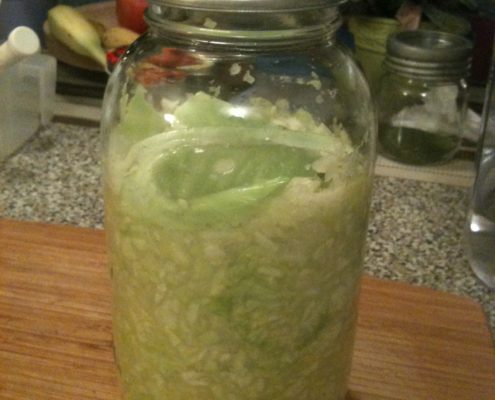Homemade Sauerkraut
Cabbage is vegetable in the brassica family and is good source of vitamin C, K and folate, a great source of protective phytochemicals & key to hormone and gut health we need during menopause. While super healthy on its own, cabbage fermented into sauerkraut raises its health benefits to a whole new level. Sauerkraut is high in fiber, nutrients, minerals and probiotics.
Eating probiotics daily is key to hormone and gut health. For more ideas to increase your intake of fermented foods check out this free guide.
What you need:
One medium green cabbage
2-3 tsp sea salt (not table salt as it has iodine in it)
What you do:
- Discard any damaged outer leaves of your cabbage, setting aside one nicer leaf.
- Slice/shred the cabbage using as sharp knife or food processor.
- Place shredded cabbage into a glass bowl.
- Add salt and massage it into cabbage mixture for a few minutes until brine starts accumulating at the bottom of your bowl. (get in there like a kitten kneading your lap or her favorite blanket :))
- Pack cabbage mixture into a clean, 1-liter glass jar, pressing down to get rid of air pockets. Pour remaining brine into the jar. Air in the jar enables bad bacteria to grow, so make sure the mixture is completely submerged.
- Use the cabbage leaf you set aside earlier and place it in the jar on top of the mixture to prevent cabbage from floating to the surface and further protect it from air.
- Place a small jelly jar, fermentation block or even a large sterilized rock on top of the mixture. This will hold the mixture below the brine during fermentation.
- Screw the lid onto your jar and leave the lid slightly loose to allow gases to escape during the fermentation process.
- Keep at room temperature and out of direct sunlight for 1–4 weeks.
You can test your kraut after seven days. The longer you allow it to ferment, the stronger the taste will be.


Notes:
Make sure you use glass or ceramic jar and bowls. Stainless steel will react with the salt and halt the fermentation process.
Add in shredded carrots, garlic, onion or beets for different flavors and creations.
I love adding sauerkraut to my morning eggs and salads – it gives that extra crunch and tangy flavor.



Share this entry